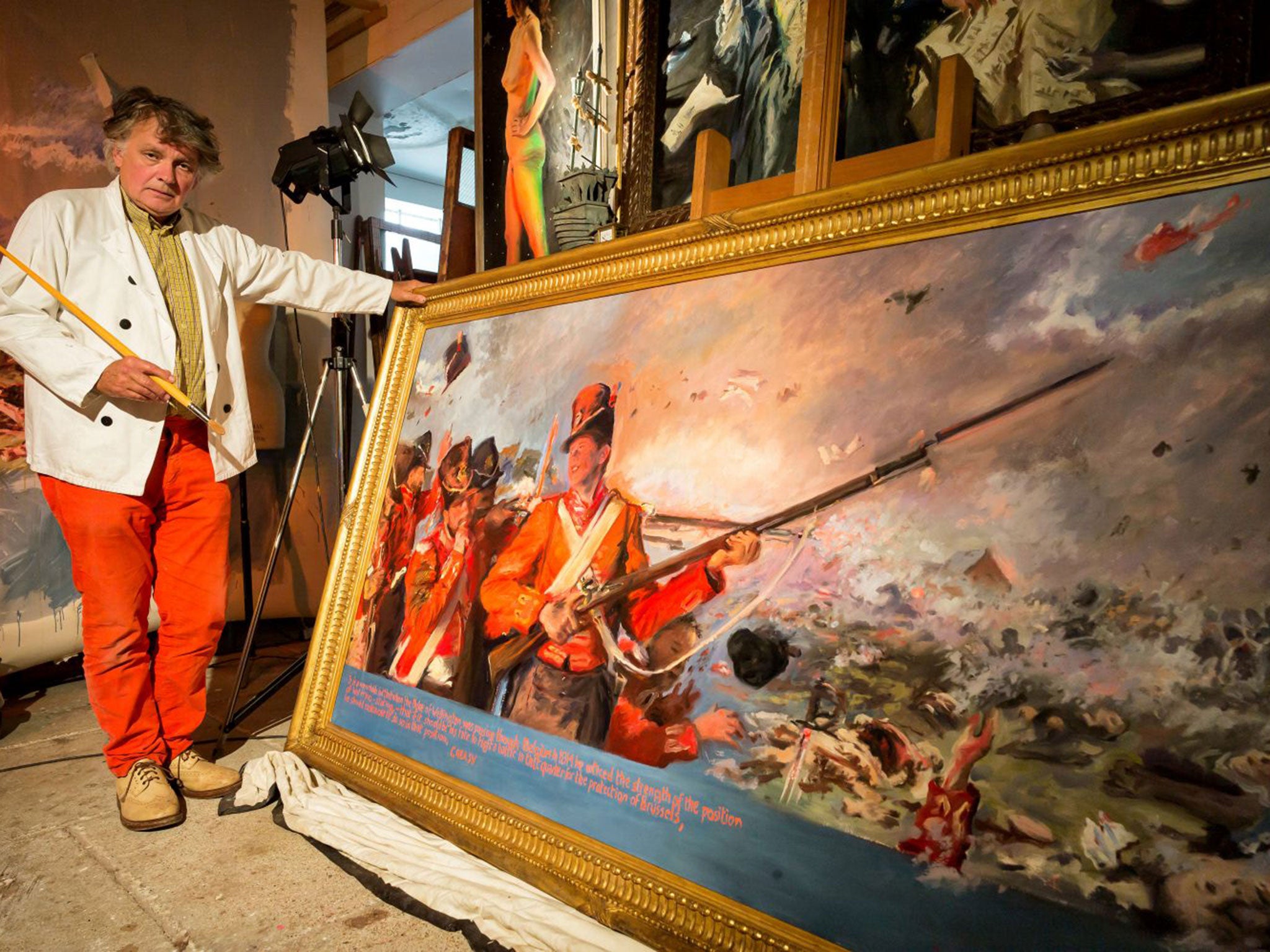Battle of Waterloo: Howard Morgan's portrait of the historic event glows with detail
It’s Waterloo, blood, guts and all – but Wellington is nowhere to be seen, writes Jim Armitage

Most painters, if commissioned by a descendant of the Duke of Wellington to depict the Battle of Waterloo, would feature the Iron Duke somewhere fairly prominently. But not Howard Morgan.
The society portrait artist – known for his paintings of the Queen and the Queen Mother, with numerous pictures in the National Portrait Gallery – decided to downplay Wellington, focusing instead on the soldiers and the carnage of battle.
Morgan was commissioned by Arthur Wellesley, Marquess of Douro, the son of the current duke, to paint a large canvas of the moment the setting sun broke through the clouds shortly before the allied victory.
Now finished to commemorate this week’s 200th anniversary of the battle, it depicts a group of British soldiers in the foreground, their red coats illuminated by the vivid pink sunlight, coming under battery fire as they face the French troops. But where is the Duke himself?
“Well, I was going to put him here at first,” Mr Morgan said, pointing with his paintbrush as he gave The Independent a sneak preview at his London studio. “But I changed my mind. I thought it would be far too literary: I mean, he was around everywhere but how many of the soldiers actually saw Wellington during this huge battle?”
Instead, where Wellington would have been, a British shako hat flies through the air, blasted from one of the thousands of allied casualties that day.
The effect of the Duke’s absence is to give a more democratic depiction of the battle, as the muddied, tired but determined troops load and fire at the wavering French and prepare to charge with bayonets fixed. In the centre, one looks back towards his men, shouting over the din to a fellow redcoat who bites open his next musket cartridge, preparing to load.
“I liked the idea of capturing this one looking back – he senses the French are about to collapse,” Morgan said.
In the distance, partly obscured by smoke from the French battery fire, is the gable of La Haye Sainte, the farm that had been a key defensive position and scene of vicious fighting.
The battlefield is a smoke-shrouded scene of the dead and the dying. Curiously, paper litter and debris are blowing through the air. Morgan, who painstakingly researched the battle, referred to descriptions of this from the soldiers who fought in it.
“People had been hit, their jackets had been ripped open and in them they were carrying letters, diaries, correspondences. The heat and smoke built up a climate that created a sort of vortex that swept it all up. And not just paper – human hair, debris.”
The images of death appalled Lord Douro’s wife, the model Jemma Kidd. “I had to tell her, ‘I’m afraid people do die in battles’,” joked Morgan.
His studio in Battersea, south London, is a glorious clutter of paint, model tall ships, costumes and commissions from his wealthy clientele – mainly portraits, many of them female nudes. By coincidence, one (a clothed example) is of a modern descendant of General Maitland, whose soldiers were in the British line next to those of General Halkett featured in the painting.
Strewn in a corner of the set he created for his Waterloo models to pose in lies a heap of redcoat uniforms he had specially made as costumes. He spattered them with mud to reflect the days and nights of rain the soldiers had endured on the retreat from the previous battle of Quatre Bras.
The models posed with heavy replica muskets for weeks while he painted, eventually only able to stand for a few minutes at a time because of the weight of the guns.
Lord Douro, who works for a City private equity firm, had originally commissioned the painting to hang in his family’s Apsley House – commonly known as No 1 London, at Hyde Park Corner.
However, he changed his mind when he saw it and decided to put it up at his Stratfield Saye estate in Hampshire, where the family spends most of its time. “The trouble was,” said Lord Douro: “It was so good I wanted it at my home instead.”
Before it disappears into his study, the painting will go on display at Mackinnon Fine Art in St James’s, London, from Monday until 1 July.
Lord Douro commissioned the work after seeing a previous painting of Morgan’s, Marlborough’s March to the Danube 1704. This featured the uniforms of the soldiers illuminated by a vivid rising sun. “He loved the sunlight and asked if I could do the same with Waterloo, but with the light coming up in the evening,” said Morgan. “And here it is.”
Morgan said he would not be attending any commemorations in the coming days. “I’ve done my bit,” he said. “All that death seems a strange thing to celebrate, don’t you think?”
Join our commenting forum
Join thought-provoking conversations, follow other Independent readers and see their replies
Comments